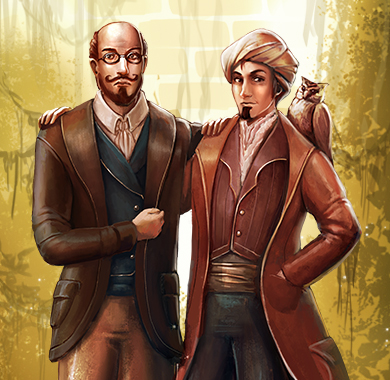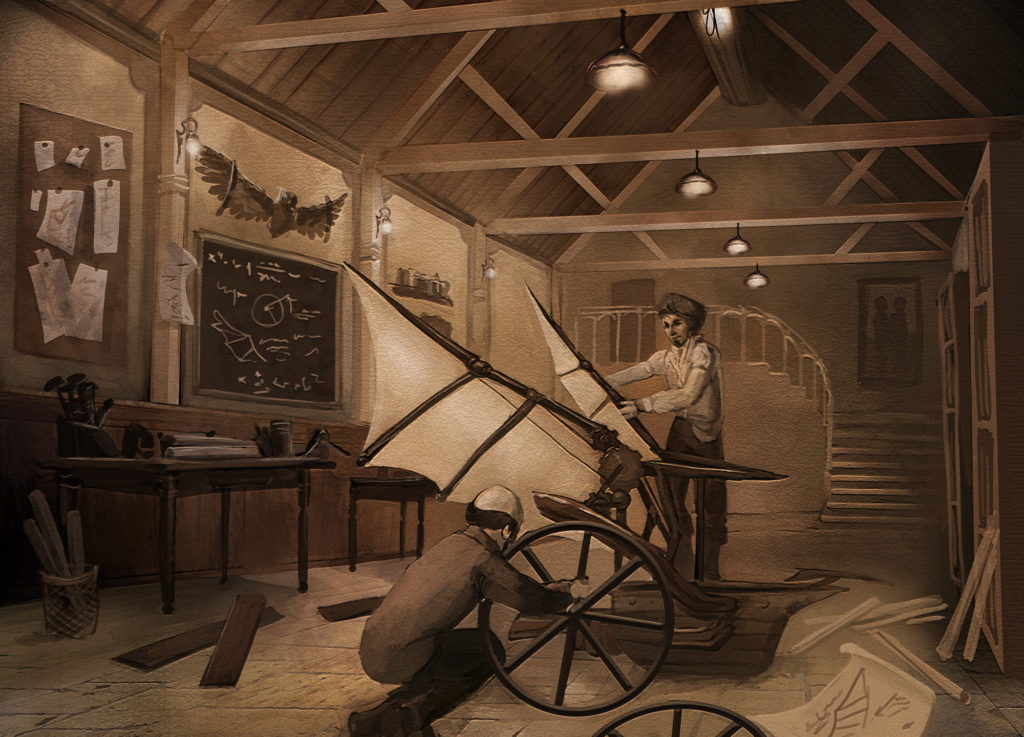The Eulenstein Brothers
Members from 1817 bis 1825


Little is known about Eckbert and Kaspar Eulenstein, the reclusive brothers who joined the Adventure Club of Europe in 1817. Even as little boys, sources close to their mother have revealed, they were constantly dreaming of taking to the skies. Due to their outstanding skills as craftsmen and inventors, the brothers were constantly in demand among the other members of the ACE, repairing all manners of mechanical devices that would break down over the course of their colleague’s adventures. Despite this, the childhood desire to be beings of the skies never left the unique minds of Eckbert and Kaspar. As we can now very well guess, they must have been secretly tinkering away for years at the various incarnations of their countless flying machines.Eckbert ‘Ecki’ Eulenstein was by far the more pragmatic of the two brothers. A trained watchmaker, he was highly skilled and technically minded and, therefore, responsible for the construction of the aircraft. Kaspar, on the other hand, was a born naturalist and his fascination with ornithology was palpable. Birds became not only a scientific obsession for Kaspar; they also brought him inspiration in the field of aerodynamics. Much of the success of their flying machine is owed his studies of the natural flight of birds. Together the brothers dedicated their every free moment to the construction of these flying machines. They did not, however, share any of their ideas with the public. Paul Mack, a wagon builder and friend of the brothers, wrote this in one of his diaries at the time:
“The Eulenstein brothers serve only two masters – themselves, and their dream of flying. They strive only for success, not fame, not glory. They have a true inventor’s spirit. They need someone to share their genius with the public. Otherwise their talents will be lost forever in the annals of time.”
Beyond their professional endeavours, the Eulenstein brothers lived a solitary life. Neither begot a family and genuine friendship was scarce. Day and night was spent in the laboratory in the company of their inventions.
“Some of their neighbours considered the brothers to be socially and mentally abnormal, or deficient to say the least”,
wrote Mack in his diaries.
“Supposedly, one of them would occasionally in the evenings run through the garden, arms spread wide, making flight noises with his mouth, and jump from a stack of crates into the grass.”
One day in 1825 the brothers disappeared without a trace.Paul Mack was the first to notice that they had not been seen at ACE headquarters for a number of weeks. With the help of the police he finally managed to open their lab and found it abandoned. On one of their workstations he found a map depicting the English Channel and something that Mack described as a ‘miniature wooden flying machine’.
Mack informed the Adventure Club of Europe about his findings and the disappearance of the brothers whereupon the members of ACE, under the direction of Hugo Hoppenstedt – then ACE President – carefully examined the Eulenstein’s documents.Countless sketches were found. Drawings of ingenious flying machines, some crumpled or crossed out, others just erratic notes. The brothers had never shared their plans and constructions with the other ACE members. However, according to their documents, they seemed to have succeeded in their quest of creating the first manned flying machine – a sensational feat.Later, a description of a meticulously planned project designed by the brothers appeared. With one of their already successfully tested machines, Volatus II, they had planned to fly to England across the English Channel.When the Adventure Club of Europe learned of their plans, immediate searches were made. Sadly, no one had seen or heard from the brothers since. The coast guard was informed and the canal was searched for weeks, to no avail.Eventually Eckbert and Kaspar Eulenstein were declared dead and all their documents were brought to the clubhouse of the ACE.There, the plans and drawings of the pioneering flying machines were lost or forgotten in the proceeding decades. Perhaps, it was thought at the time, the brothers never really had succeeded in building a functioning aircraft. After all, there had been no witnesses. It was assumed they had both failed, gripped by madness. This would make sense as nobody was able to fully understand their illegible and highly complex sketches.At the turn of the 20th Century, as the Wright brothers were celebrated worldwide for their successful achievements in flight, the Eulenstein brothers had been long forgotten.Only recently – almost 200 years later – Andrej Nikolajew, a professor from Karlsruhe, uncovered the brothers’ original sketches.His theory: 75 years before the Wright brothers, to whom the world has so wrongly attributed credit, the Eulenstein brothers really did manage to create the first manned flying machine. And who knows, maybe they really did manage to fly to England!Nikolajew has worked extensively on creating replicas of the sketched machines, which are to be on show soon at the newly opened flight laboratory.
In the possession of the Adventure Club of Europe:
Artefacts:
- Replicas
- 30 different flying machines
- Including Volatus I
Photos:
- Flying machine plans
- Pictures of the Eulenstein brothers


